CPD1102 Learning and Development Plan: Professional Growth & Ethics
VerifiedAdded on 2023/06/11
|18
|3581
|115
Report
AI Summary
This professional development and ethics report outlines a comprehensive learning and development plan. It begins with a self-introduction, highlighting the author's background as a civil engineer and their experience in project management. The report identifies key megatrends and challenges in the construction industry, including market shifts, resilience, workforce shortages, political influences, investment sizes, and technological advancements. It articulates personal goals related to delivering quality, sustainable construction projects and maximizing stakeholder returns. The report emphasizes the importance of ethical and professional values, such as safety, health, welfare, and competency. A competency assessment identifies areas for improvement in managerial, leadership, and socio-cultural skills, followed by strategies for enhancing these competencies through targeted development activities. The plan aims to address identified weaknesses and cultivate strengths for professional growth within the civil engineering sector.
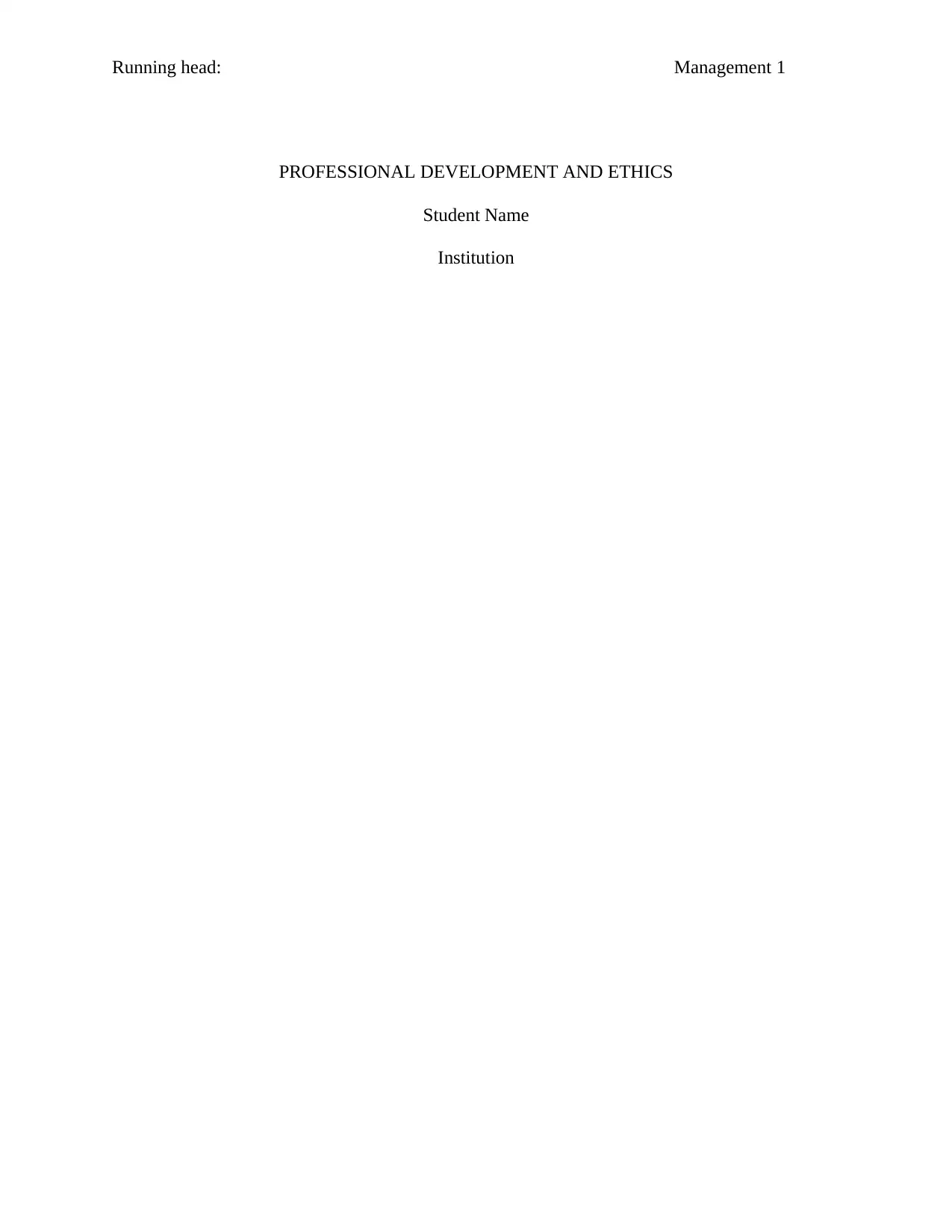
Running head: Management 1
PROFESSIONAL DEVELOPMENT AND ETHICS
Student Name
Institution
PROFESSIONAL DEVELOPMENT AND ETHICS
Student Name
Institution
Paraphrase This Document
Need a fresh take? Get an instant paraphrase of this document with our AI Paraphraser
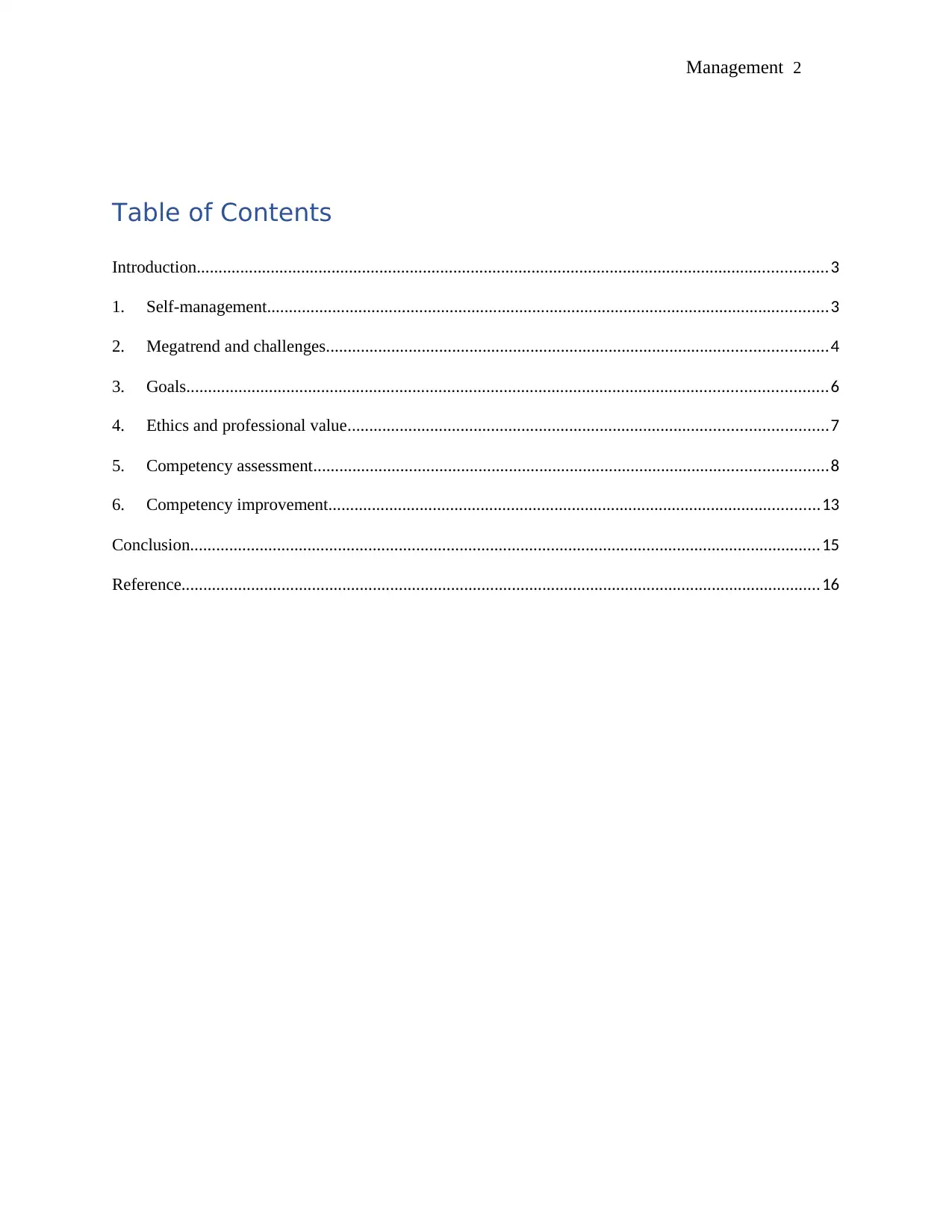
Management 2
Table of Contents
Introduction.................................................................................................................................................3
1. Self-management.................................................................................................................................3
2. Megatrend and challenges...................................................................................................................4
3. Goals...................................................................................................................................................6
4. Ethics and professional value..............................................................................................................7
5. Competency assessment......................................................................................................................8
6. Competency improvement.................................................................................................................13
Conclusion.................................................................................................................................................15
Reference...................................................................................................................................................16
Table of Contents
Introduction.................................................................................................................................................3
1. Self-management.................................................................................................................................3
2. Megatrend and challenges...................................................................................................................4
3. Goals...................................................................................................................................................6
4. Ethics and professional value..............................................................................................................7
5. Competency assessment......................................................................................................................8
6. Competency improvement.................................................................................................................13
Conclusion.................................................................................................................................................15
Reference...................................................................................................................................................16
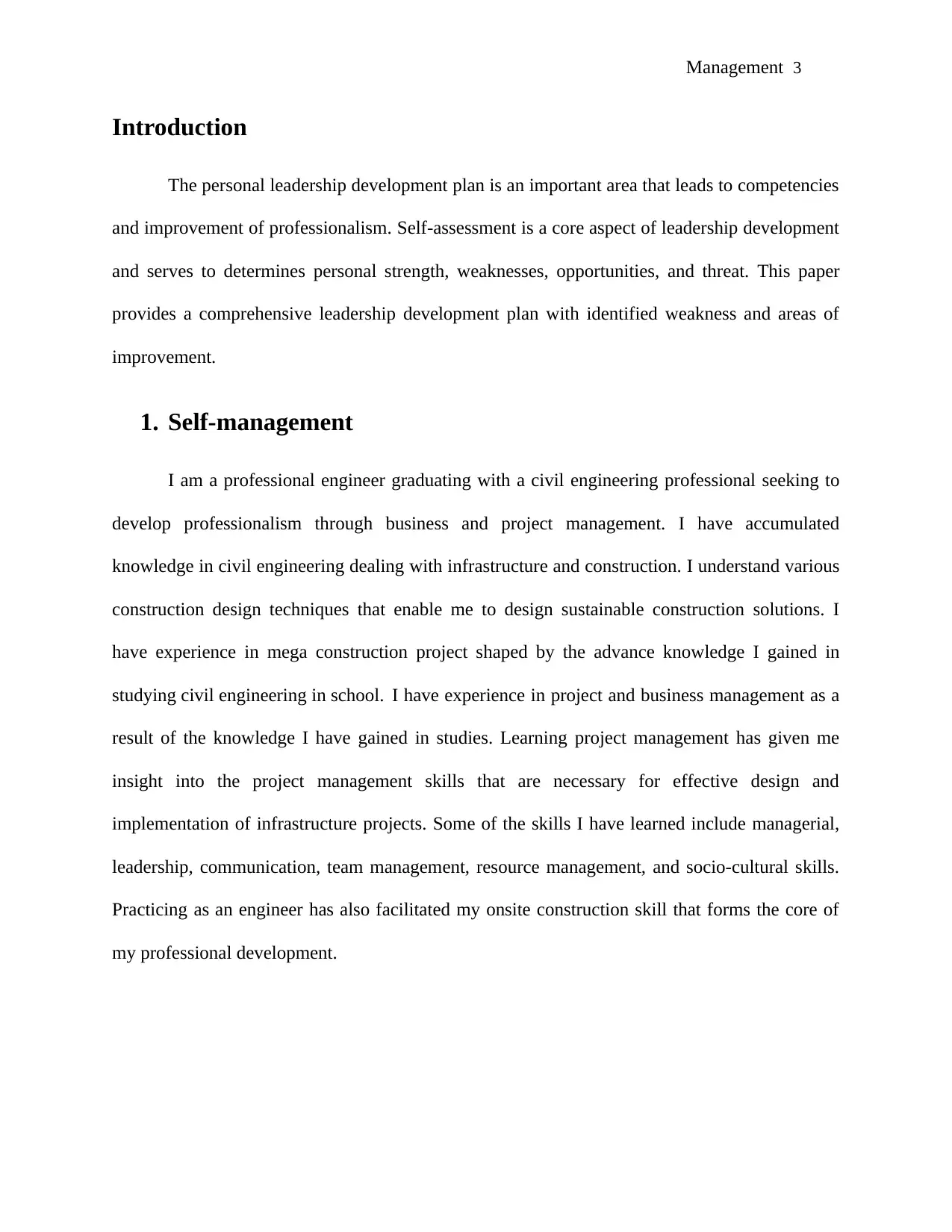
Management 3
Introduction
The personal leadership development plan is an important area that leads to competencies
and improvement of professionalism. Self-assessment is a core aspect of leadership development
and serves to determines personal strength, weaknesses, opportunities, and threat. This paper
provides a comprehensive leadership development plan with identified weakness and areas of
improvement.
1. Self-management
I am a professional engineer graduating with a civil engineering professional seeking to
develop professionalism through business and project management. I have accumulated
knowledge in civil engineering dealing with infrastructure and construction. I understand various
construction design techniques that enable me to design sustainable construction solutions. I
have experience in mega construction project shaped by the advance knowledge I gained in
studying civil engineering in school. I have experience in project and business management as a
result of the knowledge I have gained in studies. Learning project management has given me
insight into the project management skills that are necessary for effective design and
implementation of infrastructure projects. Some of the skills I have learned include managerial,
leadership, communication, team management, resource management, and socio-cultural skills.
Practicing as an engineer has also facilitated my onsite construction skill that forms the core of
my professional development.
Introduction
The personal leadership development plan is an important area that leads to competencies
and improvement of professionalism. Self-assessment is a core aspect of leadership development
and serves to determines personal strength, weaknesses, opportunities, and threat. This paper
provides a comprehensive leadership development plan with identified weakness and areas of
improvement.
1. Self-management
I am a professional engineer graduating with a civil engineering professional seeking to
develop professionalism through business and project management. I have accumulated
knowledge in civil engineering dealing with infrastructure and construction. I understand various
construction design techniques that enable me to design sustainable construction solutions. I
have experience in mega construction project shaped by the advance knowledge I gained in
studying civil engineering in school. I have experience in project and business management as a
result of the knowledge I have gained in studies. Learning project management has given me
insight into the project management skills that are necessary for effective design and
implementation of infrastructure projects. Some of the skills I have learned include managerial,
leadership, communication, team management, resource management, and socio-cultural skills.
Practicing as an engineer has also facilitated my onsite construction skill that forms the core of
my professional development.
⊘ This is a preview!⊘
Do you want full access?
Subscribe today to unlock all pages.

Trusted by 1+ million students worldwide
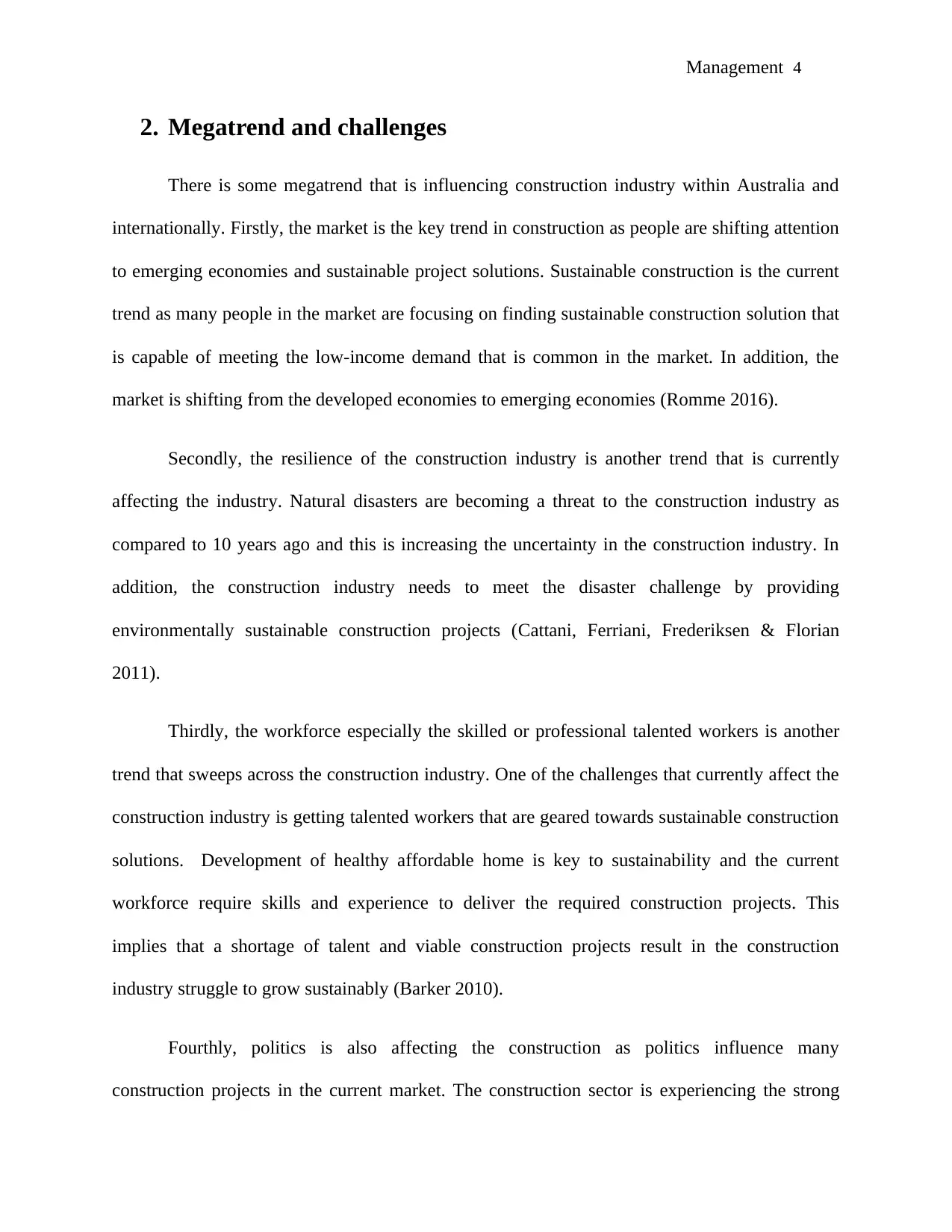
Management 4
2. Megatrend and challenges
There is some megatrend that is influencing construction industry within Australia and
internationally. Firstly, the market is the key trend in construction as people are shifting attention
to emerging economies and sustainable project solutions. Sustainable construction is the current
trend as many people in the market are focusing on finding sustainable construction solution that
is capable of meeting the low-income demand that is common in the market. In addition, the
market is shifting from the developed economies to emerging economies (Romme 2016).
Secondly, the resilience of the construction industry is another trend that is currently
affecting the industry. Natural disasters are becoming a threat to the construction industry as
compared to 10 years ago and this is increasing the uncertainty in the construction industry. In
addition, the construction industry needs to meet the disaster challenge by providing
environmentally sustainable construction projects (Cattani, Ferriani, Frederiksen & Florian
2011).
Thirdly, the workforce especially the skilled or professional talented workers is another
trend that sweeps across the construction industry. One of the challenges that currently affect the
construction industry is getting talented workers that are geared towards sustainable construction
solutions. Development of healthy affordable home is key to sustainability and the current
workforce require skills and experience to deliver the required construction projects. This
implies that a shortage of talent and viable construction projects result in the construction
industry struggle to grow sustainably (Barker 2010).
Fourthly, politics is also affecting the construction as politics influence many
construction projects in the current market. The construction sector is experiencing the strong
2. Megatrend and challenges
There is some megatrend that is influencing construction industry within Australia and
internationally. Firstly, the market is the key trend in construction as people are shifting attention
to emerging economies and sustainable project solutions. Sustainable construction is the current
trend as many people in the market are focusing on finding sustainable construction solution that
is capable of meeting the low-income demand that is common in the market. In addition, the
market is shifting from the developed economies to emerging economies (Romme 2016).
Secondly, the resilience of the construction industry is another trend that is currently
affecting the industry. Natural disasters are becoming a threat to the construction industry as
compared to 10 years ago and this is increasing the uncertainty in the construction industry. In
addition, the construction industry needs to meet the disaster challenge by providing
environmentally sustainable construction projects (Cattani, Ferriani, Frederiksen & Florian
2011).
Thirdly, the workforce especially the skilled or professional talented workers is another
trend that sweeps across the construction industry. One of the challenges that currently affect the
construction industry is getting talented workers that are geared towards sustainable construction
solutions. Development of healthy affordable home is key to sustainability and the current
workforce require skills and experience to deliver the required construction projects. This
implies that a shortage of talent and viable construction projects result in the construction
industry struggle to grow sustainably (Barker 2010).
Fourthly, politics is also affecting the construction as politics influence many
construction projects in the current market. The construction sector is experiencing the strong
Paraphrase This Document
Need a fresh take? Get an instant paraphrase of this document with our AI Paraphraser
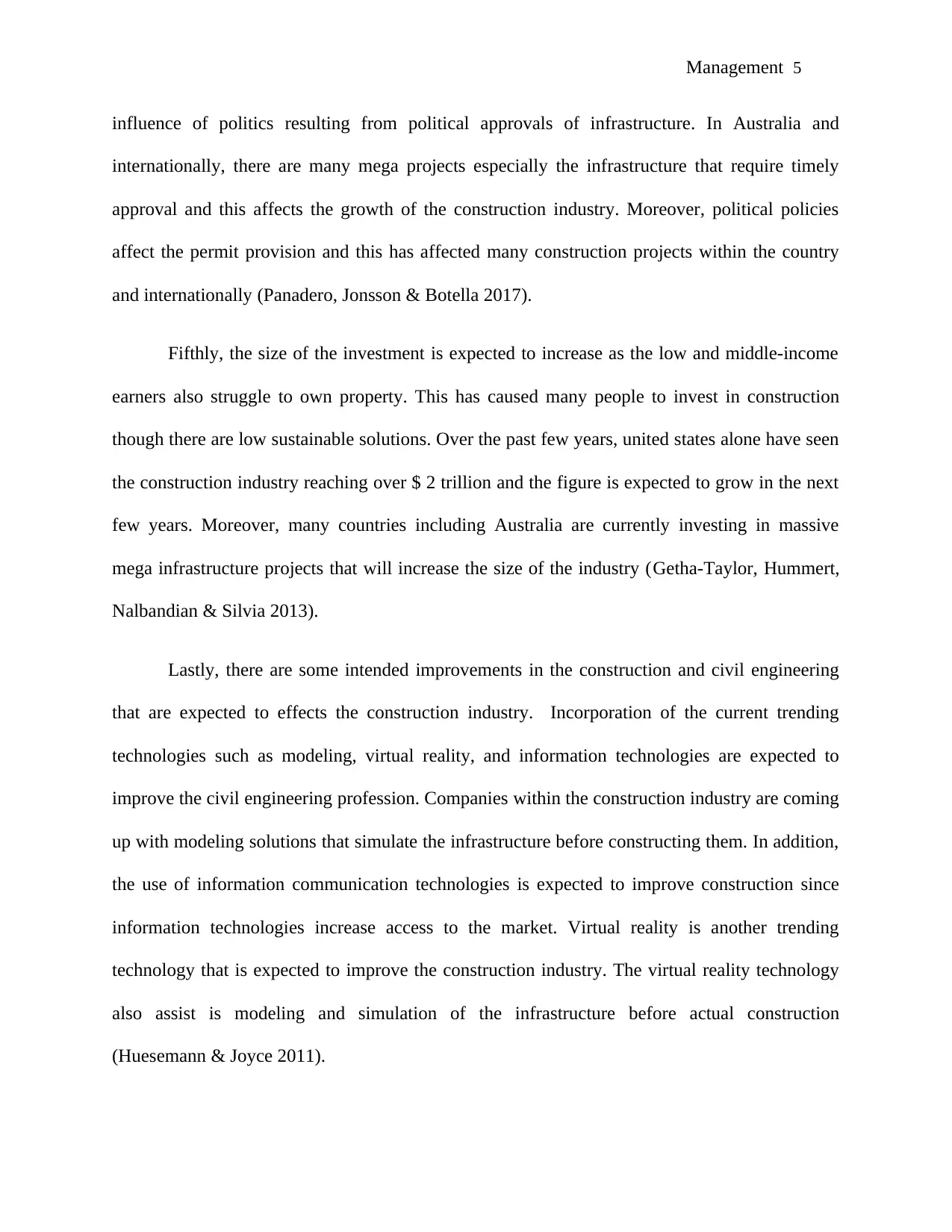
Management 5
influence of politics resulting from political approvals of infrastructure. In Australia and
internationally, there are many mega projects especially the infrastructure that require timely
approval and this affects the growth of the construction industry. Moreover, political policies
affect the permit provision and this has affected many construction projects within the country
and internationally (Panadero, Jonsson & Botella 2017).
Fifthly, the size of the investment is expected to increase as the low and middle-income
earners also struggle to own property. This has caused many people to invest in construction
though there are low sustainable solutions. Over the past few years, united states alone have seen
the construction industry reaching over $ 2 trillion and the figure is expected to grow in the next
few years. Moreover, many countries including Australia are currently investing in massive
mega infrastructure projects that will increase the size of the industry (Getha-Taylor, Hummert,
Nalbandian & Silvia 2013).
Lastly, there are some intended improvements in the construction and civil engineering
that are expected to effects the construction industry. Incorporation of the current trending
technologies such as modeling, virtual reality, and information technologies are expected to
improve the civil engineering profession. Companies within the construction industry are coming
up with modeling solutions that simulate the infrastructure before constructing them. In addition,
the use of information communication technologies is expected to improve construction since
information technologies increase access to the market. Virtual reality is another trending
technology that is expected to improve the construction industry. The virtual reality technology
also assist is modeling and simulation of the infrastructure before actual construction
(Huesemann & Joyce 2011).
influence of politics resulting from political approvals of infrastructure. In Australia and
internationally, there are many mega projects especially the infrastructure that require timely
approval and this affects the growth of the construction industry. Moreover, political policies
affect the permit provision and this has affected many construction projects within the country
and internationally (Panadero, Jonsson & Botella 2017).
Fifthly, the size of the investment is expected to increase as the low and middle-income
earners also struggle to own property. This has caused many people to invest in construction
though there are low sustainable solutions. Over the past few years, united states alone have seen
the construction industry reaching over $ 2 trillion and the figure is expected to grow in the next
few years. Moreover, many countries including Australia are currently investing in massive
mega infrastructure projects that will increase the size of the industry (Getha-Taylor, Hummert,
Nalbandian & Silvia 2013).
Lastly, there are some intended improvements in the construction and civil engineering
that are expected to effects the construction industry. Incorporation of the current trending
technologies such as modeling, virtual reality, and information technologies are expected to
improve the civil engineering profession. Companies within the construction industry are coming
up with modeling solutions that simulate the infrastructure before constructing them. In addition,
the use of information communication technologies is expected to improve construction since
information technologies increase access to the market. Virtual reality is another trending
technology that is expected to improve the construction industry. The virtual reality technology
also assist is modeling and simulation of the infrastructure before actual construction
(Huesemann & Joyce 2011).
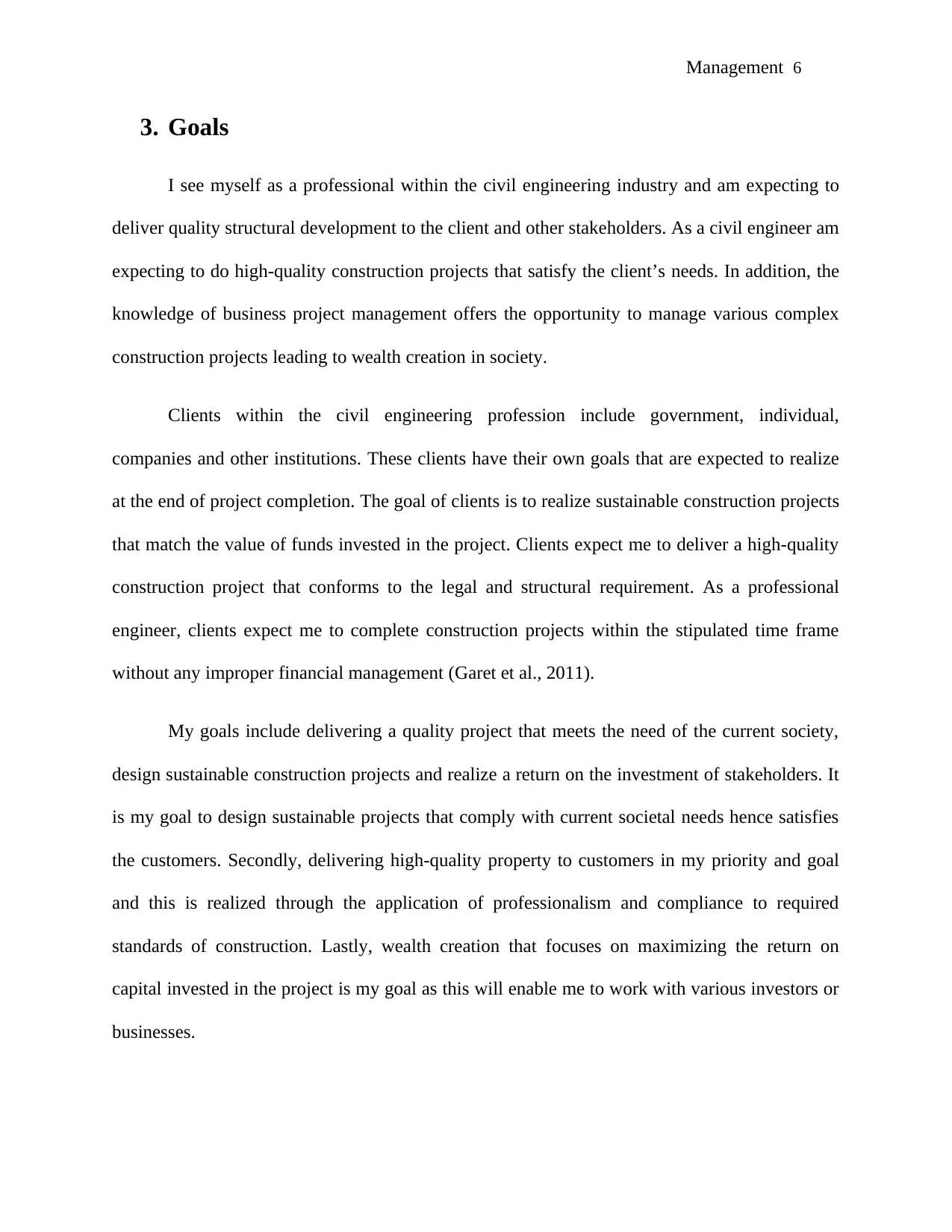
Management 6
3. Goals
I see myself as a professional within the civil engineering industry and am expecting to
deliver quality structural development to the client and other stakeholders. As a civil engineer am
expecting to do high-quality construction projects that satisfy the client’s needs. In addition, the
knowledge of business project management offers the opportunity to manage various complex
construction projects leading to wealth creation in society.
Clients within the civil engineering profession include government, individual,
companies and other institutions. These clients have their own goals that are expected to realize
at the end of project completion. The goal of clients is to realize sustainable construction projects
that match the value of funds invested in the project. Clients expect me to deliver a high-quality
construction project that conforms to the legal and structural requirement. As a professional
engineer, clients expect me to complete construction projects within the stipulated time frame
without any improper financial management (Garet et al., 2011).
My goals include delivering a quality project that meets the need of the current society,
design sustainable construction projects and realize a return on the investment of stakeholders. It
is my goal to design sustainable projects that comply with current societal needs hence satisfies
the customers. Secondly, delivering high-quality property to customers in my priority and goal
and this is realized through the application of professionalism and compliance to required
standards of construction. Lastly, wealth creation that focuses on maximizing the return on
capital invested in the project is my goal as this will enable me to work with various investors or
businesses.
3. Goals
I see myself as a professional within the civil engineering industry and am expecting to
deliver quality structural development to the client and other stakeholders. As a civil engineer am
expecting to do high-quality construction projects that satisfy the client’s needs. In addition, the
knowledge of business project management offers the opportunity to manage various complex
construction projects leading to wealth creation in society.
Clients within the civil engineering profession include government, individual,
companies and other institutions. These clients have their own goals that are expected to realize
at the end of project completion. The goal of clients is to realize sustainable construction projects
that match the value of funds invested in the project. Clients expect me to deliver a high-quality
construction project that conforms to the legal and structural requirement. As a professional
engineer, clients expect me to complete construction projects within the stipulated time frame
without any improper financial management (Garet et al., 2011).
My goals include delivering a quality project that meets the need of the current society,
design sustainable construction projects and realize a return on the investment of stakeholders. It
is my goal to design sustainable projects that comply with current societal needs hence satisfies
the customers. Secondly, delivering high-quality property to customers in my priority and goal
and this is realized through the application of professionalism and compliance to required
standards of construction. Lastly, wealth creation that focuses on maximizing the return on
capital invested in the project is my goal as this will enable me to work with various investors or
businesses.
⊘ This is a preview!⊘
Do you want full access?
Subscribe today to unlock all pages.

Trusted by 1+ million students worldwide
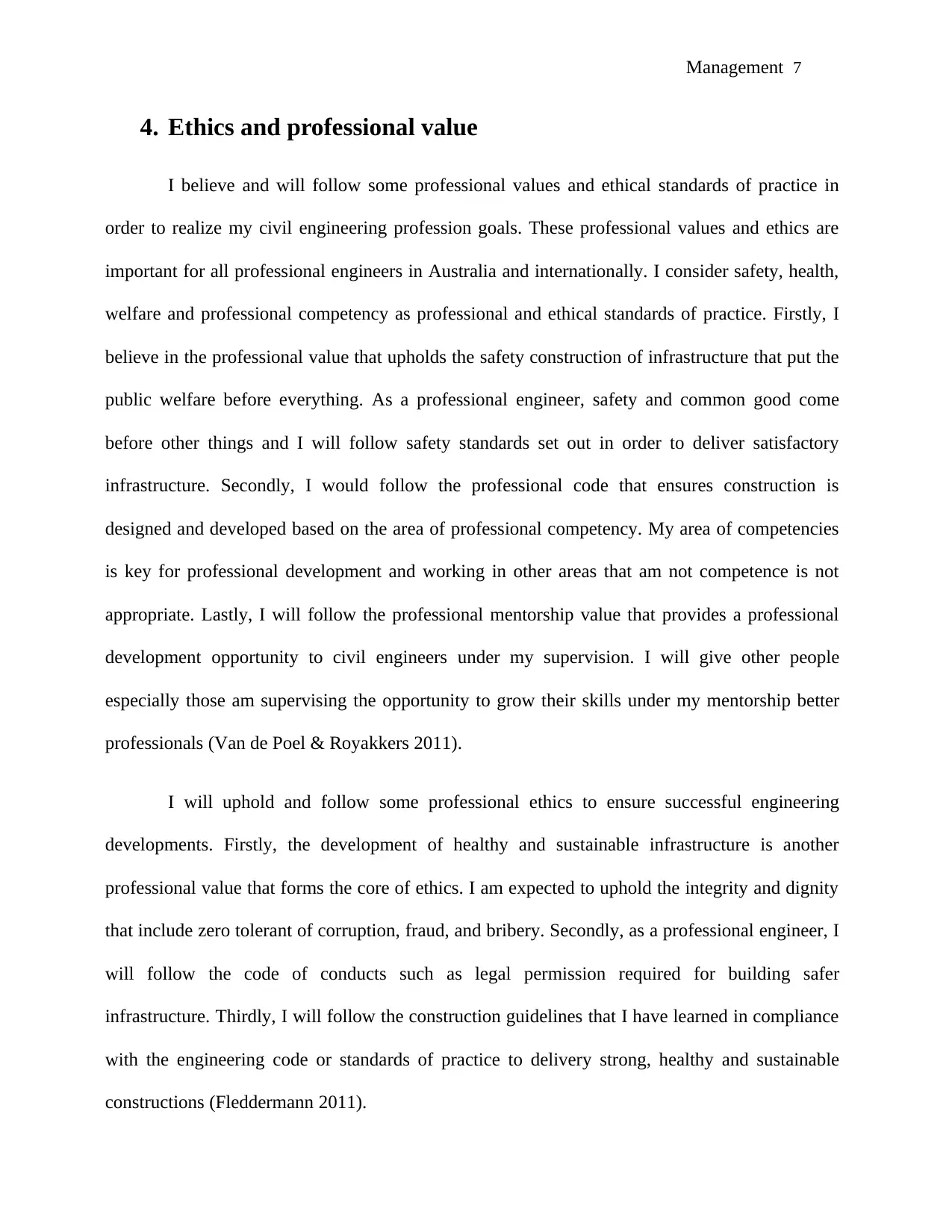
Management 7
4. Ethics and professional value
I believe and will follow some professional values and ethical standards of practice in
order to realize my civil engineering profession goals. These professional values and ethics are
important for all professional engineers in Australia and internationally. I consider safety, health,
welfare and professional competency as professional and ethical standards of practice. Firstly, I
believe in the professional value that upholds the safety construction of infrastructure that put the
public welfare before everything. As a professional engineer, safety and common good come
before other things and I will follow safety standards set out in order to deliver satisfactory
infrastructure. Secondly, I would follow the professional code that ensures construction is
designed and developed based on the area of professional competency. My area of competencies
is key for professional development and working in other areas that am not competence is not
appropriate. Lastly, I will follow the professional mentorship value that provides a professional
development opportunity to civil engineers under my supervision. I will give other people
especially those am supervising the opportunity to grow their skills under my mentorship better
professionals (Van de Poel & Royakkers 2011).
I will uphold and follow some professional ethics to ensure successful engineering
developments. Firstly, the development of healthy and sustainable infrastructure is another
professional value that forms the core of ethics. I am expected to uphold the integrity and dignity
that include zero tolerant of corruption, fraud, and bribery. Secondly, as a professional engineer, I
will follow the code of conducts such as legal permission required for building safer
infrastructure. Thirdly, I will follow the construction guidelines that I have learned in compliance
with the engineering code or standards of practice to delivery strong, healthy and sustainable
constructions (Fleddermann 2011).
4. Ethics and professional value
I believe and will follow some professional values and ethical standards of practice in
order to realize my civil engineering profession goals. These professional values and ethics are
important for all professional engineers in Australia and internationally. I consider safety, health,
welfare and professional competency as professional and ethical standards of practice. Firstly, I
believe in the professional value that upholds the safety construction of infrastructure that put the
public welfare before everything. As a professional engineer, safety and common good come
before other things and I will follow safety standards set out in order to deliver satisfactory
infrastructure. Secondly, I would follow the professional code that ensures construction is
designed and developed based on the area of professional competency. My area of competencies
is key for professional development and working in other areas that am not competence is not
appropriate. Lastly, I will follow the professional mentorship value that provides a professional
development opportunity to civil engineers under my supervision. I will give other people
especially those am supervising the opportunity to grow their skills under my mentorship better
professionals (Van de Poel & Royakkers 2011).
I will uphold and follow some professional ethics to ensure successful engineering
developments. Firstly, the development of healthy and sustainable infrastructure is another
professional value that forms the core of ethics. I am expected to uphold the integrity and dignity
that include zero tolerant of corruption, fraud, and bribery. Secondly, as a professional engineer, I
will follow the code of conducts such as legal permission required for building safer
infrastructure. Thirdly, I will follow the construction guidelines that I have learned in compliance
with the engineering code or standards of practice to delivery strong, healthy and sustainable
constructions (Fleddermann 2011).
Paraphrase This Document
Need a fresh take? Get an instant paraphrase of this document with our AI Paraphraser
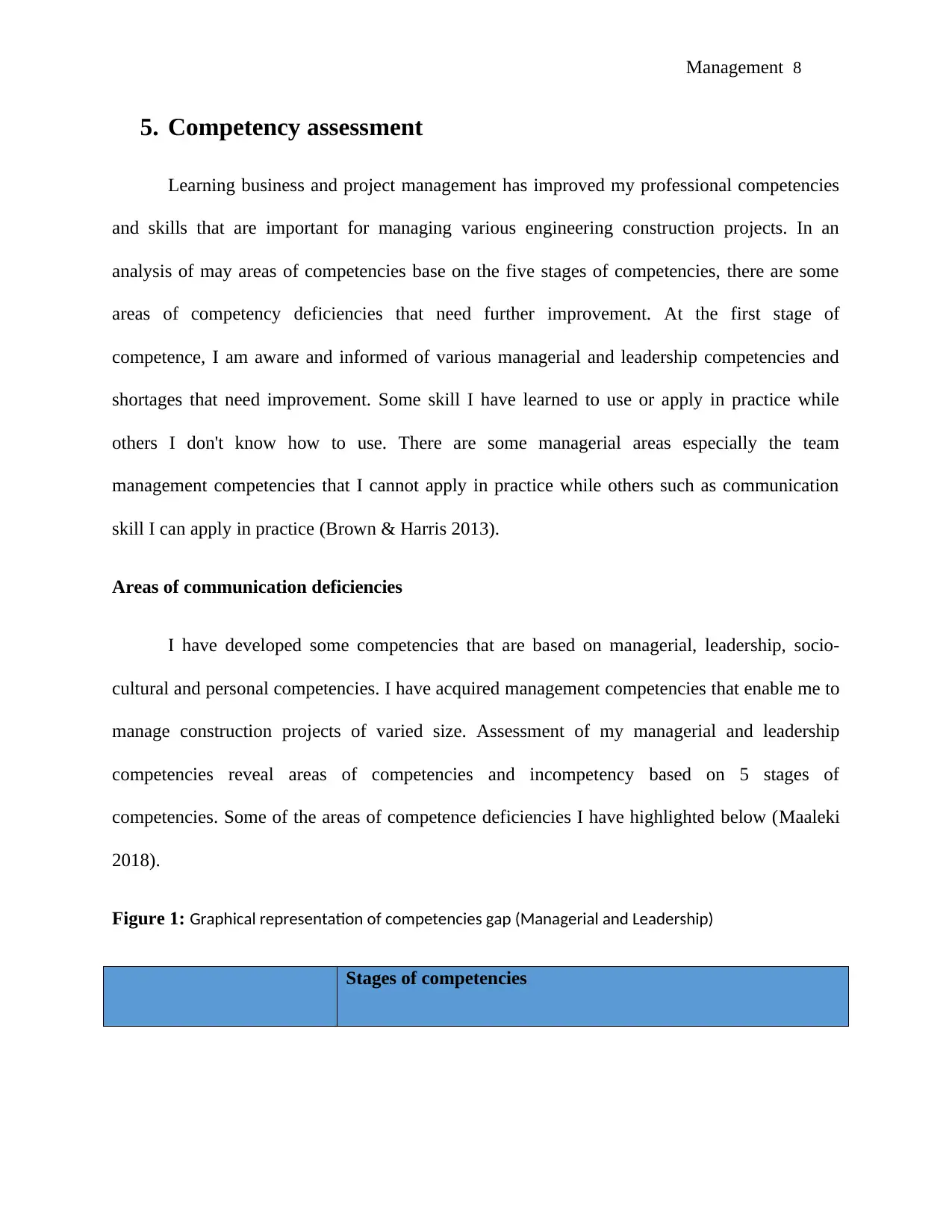
Management 8
5. Competency assessment
Learning business and project management has improved my professional competencies
and skills that are important for managing various engineering construction projects. In an
analysis of may areas of competencies base on the five stages of competencies, there are some
areas of competency deficiencies that need further improvement. At the first stage of
competence, I am aware and informed of various managerial and leadership competencies and
shortages that need improvement. Some skill I have learned to use or apply in practice while
others I don't know how to use. There are some managerial areas especially the team
management competencies that I cannot apply in practice while others such as communication
skill I can apply in practice (Brown & Harris 2013).
Areas of communication deficiencies
I have developed some competencies that are based on managerial, leadership, socio-
cultural and personal competencies. I have acquired management competencies that enable me to
manage construction projects of varied size. Assessment of my managerial and leadership
competencies reveal areas of competencies and incompetency based on 5 stages of
competencies. Some of the areas of competence deficiencies I have highlighted below (Maaleki
2018).
Figure 1: Graphical representation of competencies gap (Managerial and Leadership)
Stages of competencies
5. Competency assessment
Learning business and project management has improved my professional competencies
and skills that are important for managing various engineering construction projects. In an
analysis of may areas of competencies base on the five stages of competencies, there are some
areas of competency deficiencies that need further improvement. At the first stage of
competence, I am aware and informed of various managerial and leadership competencies and
shortages that need improvement. Some skill I have learned to use or apply in practice while
others I don't know how to use. There are some managerial areas especially the team
management competencies that I cannot apply in practice while others such as communication
skill I can apply in practice (Brown & Harris 2013).
Areas of communication deficiencies
I have developed some competencies that are based on managerial, leadership, socio-
cultural and personal competencies. I have acquired management competencies that enable me to
manage construction projects of varied size. Assessment of my managerial and leadership
competencies reveal areas of competencies and incompetency based on 5 stages of
competencies. Some of the areas of competence deficiencies I have highlighted below (Maaleki
2018).
Figure 1: Graphical representation of competencies gap (Managerial and Leadership)
Stages of competencies
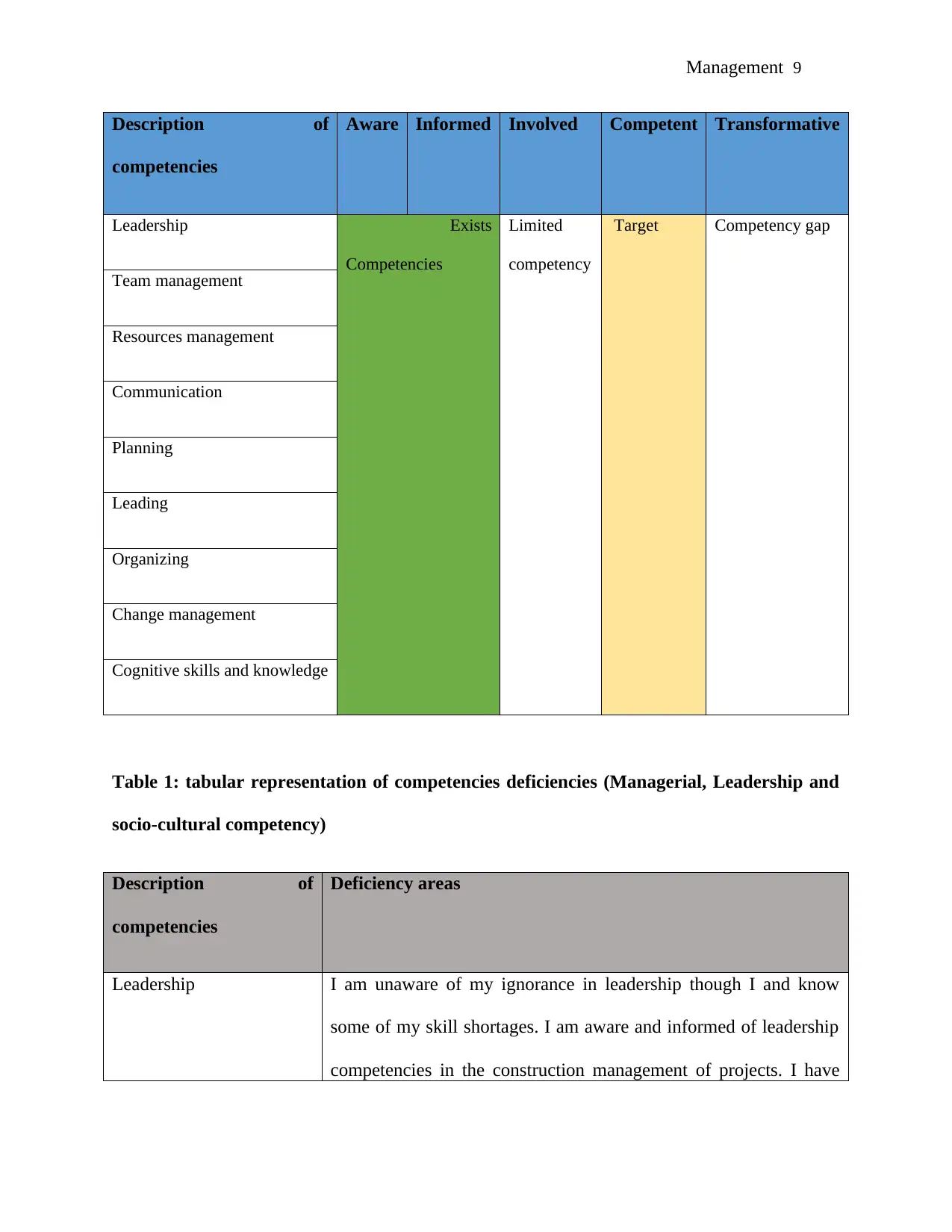
Management 9
Description of
competencies
Aware Informed Involved Competent Transformative
Leadership Exists
Competencies
Limited
competency
Target Competency gap
Team management
Resources management
Communication
Planning
Leading
Organizing
Change management
Cognitive skills and knowledge
Table 1: tabular representation of competencies deficiencies (Managerial, Leadership and
socio-cultural competency)
Description of
competencies
Deficiency areas
Leadership I am unaware of my ignorance in leadership though I and know
some of my skill shortages. I am aware and informed of leadership
competencies in the construction management of projects. I have
Description of
competencies
Aware Informed Involved Competent Transformative
Leadership Exists
Competencies
Limited
competency
Target Competency gap
Team management
Resources management
Communication
Planning
Leading
Organizing
Change management
Cognitive skills and knowledge
Table 1: tabular representation of competencies deficiencies (Managerial, Leadership and
socio-cultural competency)
Description of
competencies
Deficiency areas
Leadership I am unaware of my ignorance in leadership though I and know
some of my skill shortages. I am aware and informed of leadership
competencies in the construction management of projects. I have
⊘ This is a preview!⊘
Do you want full access?
Subscribe today to unlock all pages.

Trusted by 1+ million students worldwide
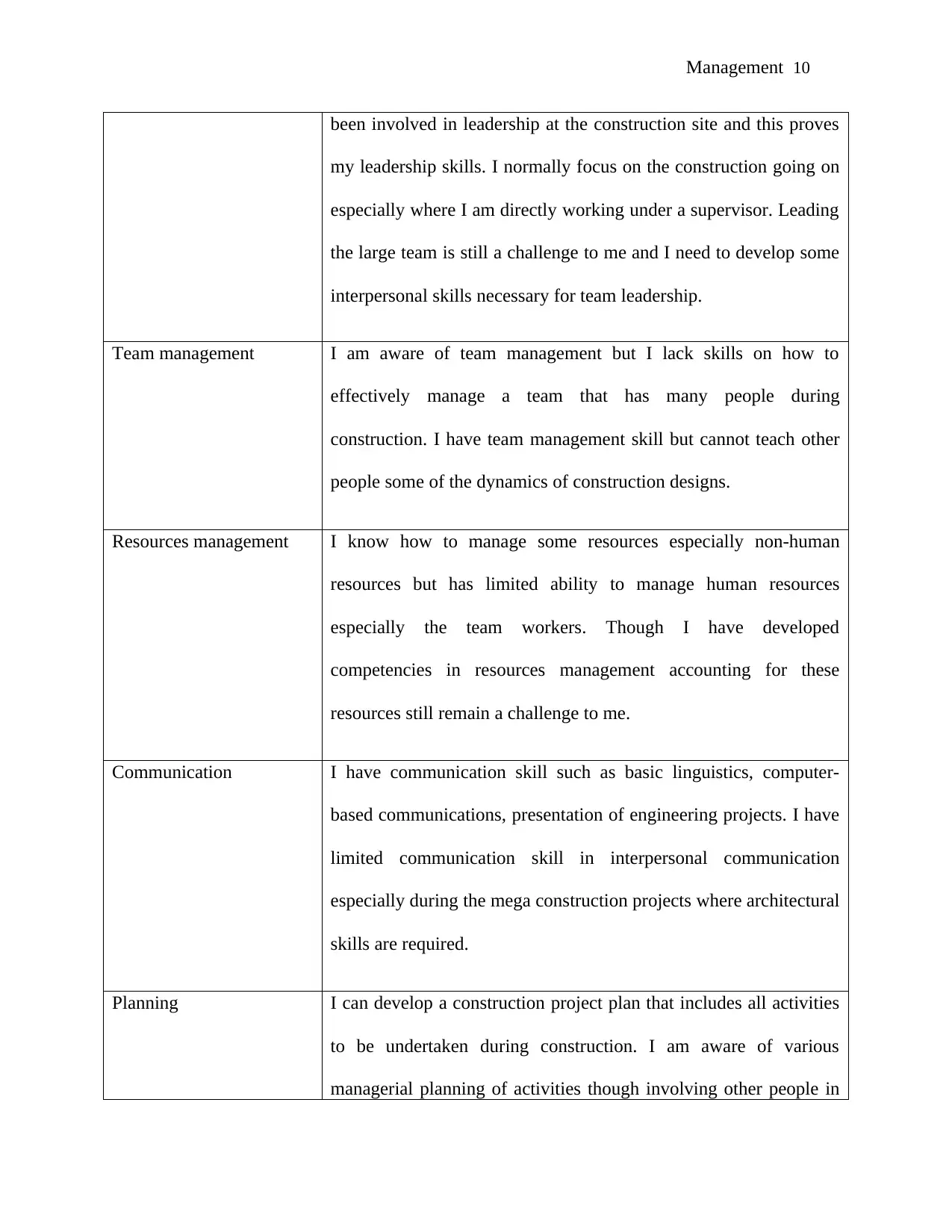
Management 10
been involved in leadership at the construction site and this proves
my leadership skills. I normally focus on the construction going on
especially where I am directly working under a supervisor. Leading
the large team is still a challenge to me and I need to develop some
interpersonal skills necessary for team leadership.
Team management I am aware of team management but I lack skills on how to
effectively manage a team that has many people during
construction. I have team management skill but cannot teach other
people some of the dynamics of construction designs.
Resources management I know how to manage some resources especially non-human
resources but has limited ability to manage human resources
especially the team workers. Though I have developed
competencies in resources management accounting for these
resources still remain a challenge to me.
Communication I have communication skill such as basic linguistics, computer-
based communications, presentation of engineering projects. I have
limited communication skill in interpersonal communication
especially during the mega construction projects where architectural
skills are required.
Planning I can develop a construction project plan that includes all activities
to be undertaken during construction. I am aware of various
managerial planning of activities though involving other people in
been involved in leadership at the construction site and this proves
my leadership skills. I normally focus on the construction going on
especially where I am directly working under a supervisor. Leading
the large team is still a challenge to me and I need to develop some
interpersonal skills necessary for team leadership.
Team management I am aware of team management but I lack skills on how to
effectively manage a team that has many people during
construction. I have team management skill but cannot teach other
people some of the dynamics of construction designs.
Resources management I know how to manage some resources especially non-human
resources but has limited ability to manage human resources
especially the team workers. Though I have developed
competencies in resources management accounting for these
resources still remain a challenge to me.
Communication I have communication skill such as basic linguistics, computer-
based communications, presentation of engineering projects. I have
limited communication skill in interpersonal communication
especially during the mega construction projects where architectural
skills are required.
Planning I can develop a construction project plan that includes all activities
to be undertaken during construction. I am aware of various
managerial planning of activities though involving other people in
Paraphrase This Document
Need a fresh take? Get an instant paraphrase of this document with our AI Paraphraser
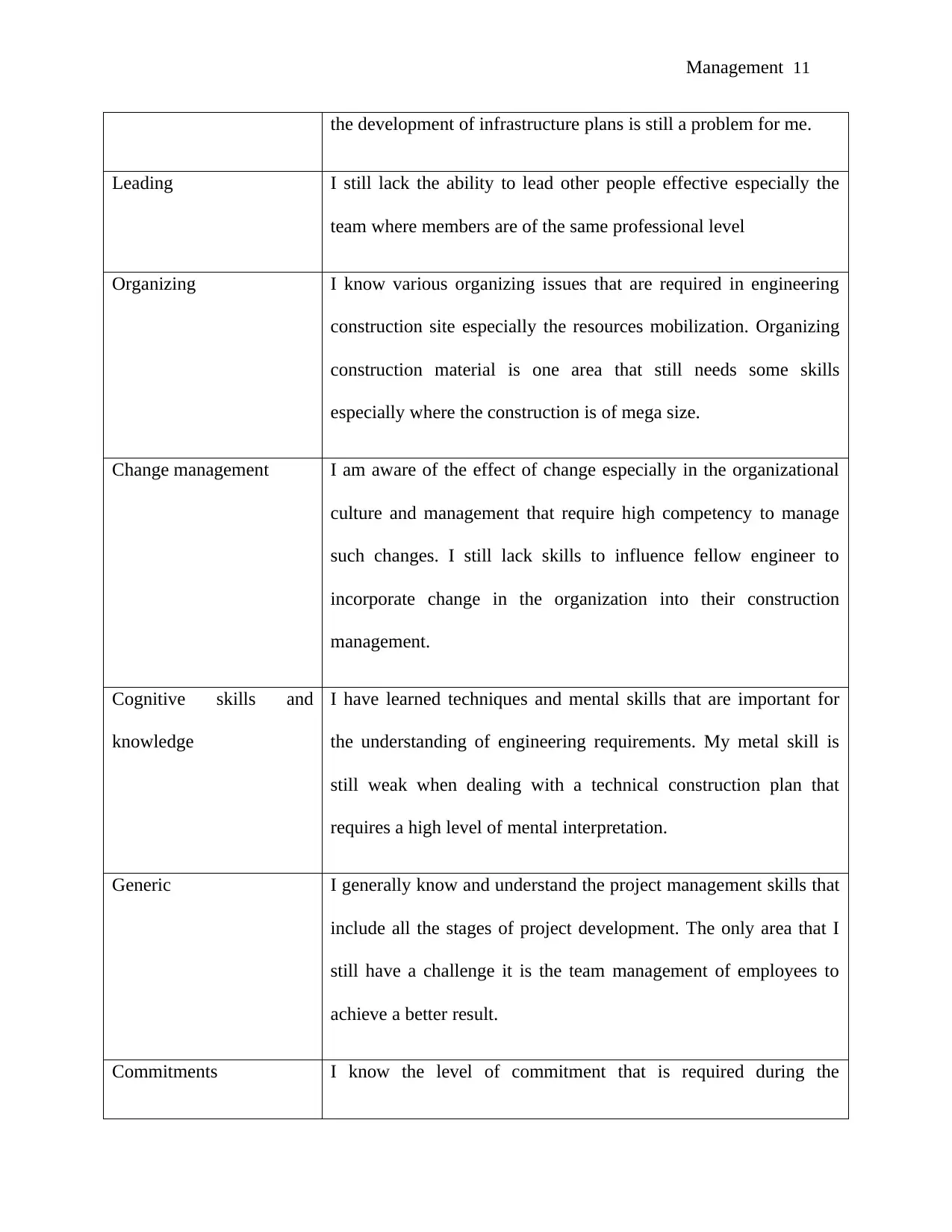
Management 11
the development of infrastructure plans is still a problem for me.
Leading I still lack the ability to lead other people effective especially the
team where members are of the same professional level
Organizing I know various organizing issues that are required in engineering
construction site especially the resources mobilization. Organizing
construction material is one area that still needs some skills
especially where the construction is of mega size.
Change management I am aware of the effect of change especially in the organizational
culture and management that require high competency to manage
such changes. I still lack skills to influence fellow engineer to
incorporate change in the organization into their construction
management.
Cognitive skills and
knowledge
I have learned techniques and mental skills that are important for
the understanding of engineering requirements. My metal skill is
still weak when dealing with a technical construction plan that
requires a high level of mental interpretation.
Generic I generally know and understand the project management skills that
include all the stages of project development. The only area that I
still have a challenge it is the team management of employees to
achieve a better result.
Commitments I know the level of commitment that is required during the
the development of infrastructure plans is still a problem for me.
Leading I still lack the ability to lead other people effective especially the
team where members are of the same professional level
Organizing I know various organizing issues that are required in engineering
construction site especially the resources mobilization. Organizing
construction material is one area that still needs some skills
especially where the construction is of mega size.
Change management I am aware of the effect of change especially in the organizational
culture and management that require high competency to manage
such changes. I still lack skills to influence fellow engineer to
incorporate change in the organization into their construction
management.
Cognitive skills and
knowledge
I have learned techniques and mental skills that are important for
the understanding of engineering requirements. My metal skill is
still weak when dealing with a technical construction plan that
requires a high level of mental interpretation.
Generic I generally know and understand the project management skills that
include all the stages of project development. The only area that I
still have a challenge it is the team management of employees to
achieve a better result.
Commitments I know the level of commitment that is required during the
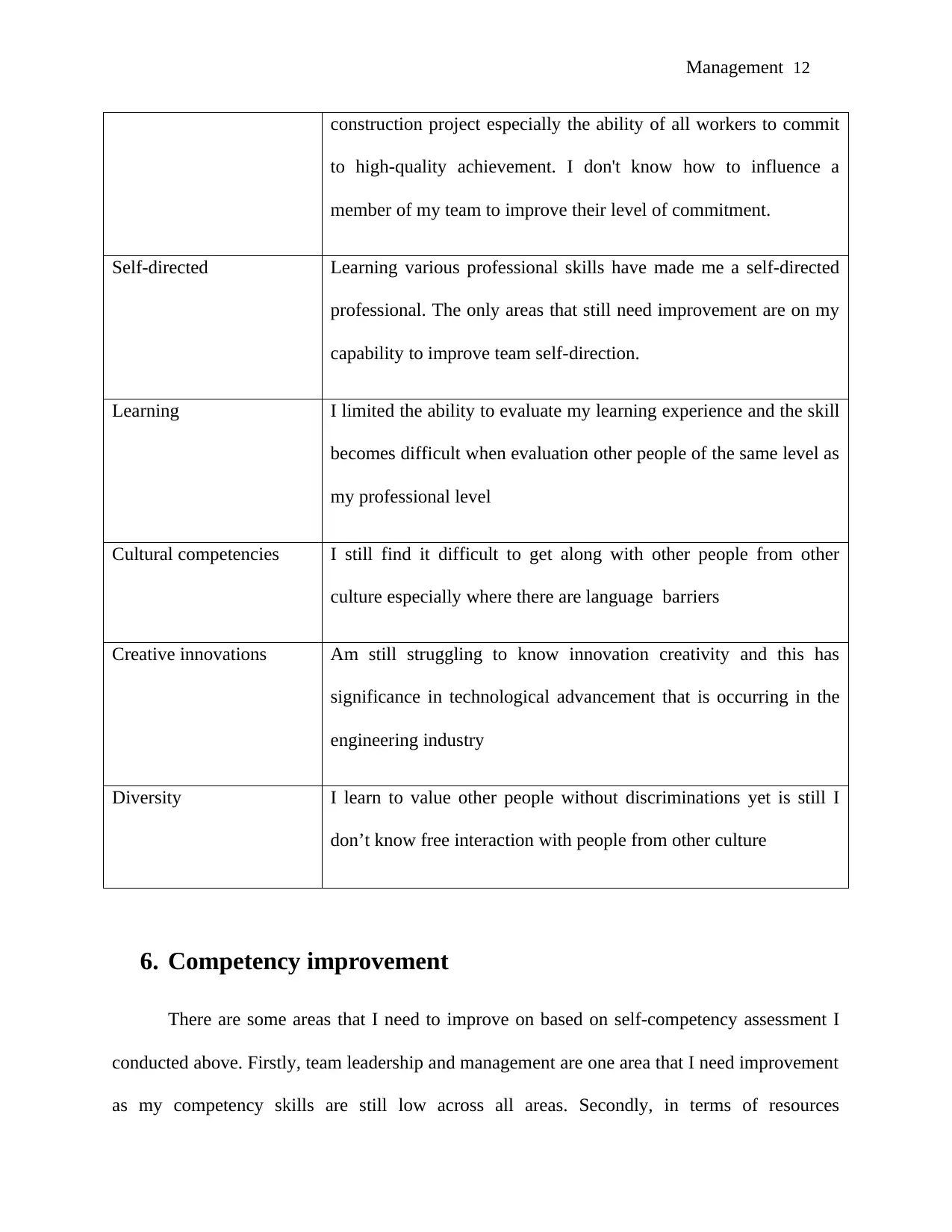
Management 12
construction project especially the ability of all workers to commit
to high-quality achievement. I don't know how to influence a
member of my team to improve their level of commitment.
Self-directed Learning various professional skills have made me a self-directed
professional. The only areas that still need improvement are on my
capability to improve team self-direction.
Learning I limited the ability to evaluate my learning experience and the skill
becomes difficult when evaluation other people of the same level as
my professional level
Cultural competencies I still find it difficult to get along with other people from other
culture especially where there are language barriers
Creative innovations Am still struggling to know innovation creativity and this has
significance in technological advancement that is occurring in the
engineering industry
Diversity I learn to value other people without discriminations yet is still I
don’t know free interaction with people from other culture
6. Competency improvement
There are some areas that I need to improve on based on self-competency assessment I
conducted above. Firstly, team leadership and management are one area that I need improvement
as my competency skills are still low across all areas. Secondly, in terms of resources
construction project especially the ability of all workers to commit
to high-quality achievement. I don't know how to influence a
member of my team to improve their level of commitment.
Self-directed Learning various professional skills have made me a self-directed
professional. The only areas that still need improvement are on my
capability to improve team self-direction.
Learning I limited the ability to evaluate my learning experience and the skill
becomes difficult when evaluation other people of the same level as
my professional level
Cultural competencies I still find it difficult to get along with other people from other
culture especially where there are language barriers
Creative innovations Am still struggling to know innovation creativity and this has
significance in technological advancement that is occurring in the
engineering industry
Diversity I learn to value other people without discriminations yet is still I
don’t know free interaction with people from other culture
6. Competency improvement
There are some areas that I need to improve on based on self-competency assessment I
conducted above. Firstly, team leadership and management are one area that I need improvement
as my competency skills are still low across all areas. Secondly, in terms of resources
⊘ This is a preview!⊘
Do you want full access?
Subscribe today to unlock all pages.

Trusted by 1+ million students worldwide
1 out of 18
Related Documents
Your All-in-One AI-Powered Toolkit for Academic Success.
+13062052269
info@desklib.com
Available 24*7 on WhatsApp / Email
![[object Object]](/_next/static/media/star-bottom.7253800d.svg)
Unlock your academic potential
Copyright © 2020–2025 A2Z Services. All Rights Reserved. Developed and managed by ZUCOL.




